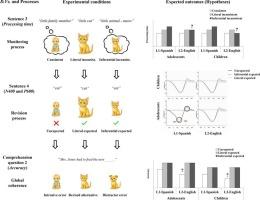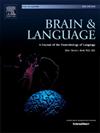Developmental differences in L1 and L2 text comprehension: An ERP study
IF 2.3
2区 心理学
Q1 AUDIOLOGY & SPEECH-LANGUAGE PATHOLOGY
引用次数: 0
Abstract
Text comprehension relies on high-level cognitive processes. These processes might be challenging for young readers, especially when comprehension takes place in a non-native language, an issue that remains unexplored. Twenty-four children and twenty-six adolescent early sequential bilinguals, were presented with narratives in L1-Spanish and L2-English. Each text biased an initial inference (“baby”), which then required either literal (“The little cat…”) or inferential (“The little animal − meow…”) monitoring. Processing times at this sentence suggested less efficient comprehension monitoring in the L2, mainly with inferential information. Moreover, in a final sentence, either literal or inferential (depending on the previous sentence) revision was assessed by ERP to a disambiguating word (“cat”). N400 amplitude showed that adolescents semantically integrated the alternative concept into their situation model only in the native language, but not during L2 comprehension. Crucially, children struggled to do so in both languages. In contrast, the P600 suggested that children in the native language and adolescents in both languages performed semantic reanalyses by reducing interference from the no longer valid initial interpretation. Our findings indicate a complex interplay between development and bilingualism in the ability to revise a situation model during text comprehension.

母语和二语文本理解的发展差异:一个ERP研究
文本理解依赖于高层次的认知过程。这些过程对年轻的读者来说可能是具有挑战性的,特别是当用非母语进行理解时,这是一个尚未探索的问题。24名儿童和26名青少年早期顺序双语者,以l1 -西班牙语和l2 -英语进行叙述。每个文本都有一个初始推理(“婴儿”),然后需要字面上的(“小猫……”)或推理(“小动物-喵喵……”)监控。这句话的处理时间表明第二语言的理解监测效率较低,主要是推理信息。此外,在最后一个句子中,通过ERP评估对消歧义词(“cat”)的字面或推理(取决于前一个句子)修订。N400振幅表明,青少年仅在母语情境模型中语义整合了替代概念,而在二语理解过程中则没有。至关重要的是,孩子们用两种语言都很难做到这一点。相比之下,P600表明母语儿童和两种语言青少年通过减少不再有效的初始解释的干扰来进行语义重新分析。我们的研究结果表明,在文本理解过程中修改情境模型的能力与双语能力之间存在复杂的相互作用。
本文章由计算机程序翻译,如有差异,请以英文原文为准。
求助全文
约1分钟内获得全文
求助全文
来源期刊

Brain and Language
医学-神经科学
CiteScore
4.50
自引率
8.00%
发文量
82
审稿时长
20.5 weeks
期刊介绍:
An interdisciplinary journal, Brain and Language publishes articles that elucidate the complex relationships among language, brain, and behavior. The journal covers the large variety of modern techniques in cognitive neuroscience, including functional and structural brain imaging, electrophysiology, cellular and molecular neurobiology, genetics, lesion-based approaches, and computational modeling. All articles must relate to human language and be relevant to the understanding of its neurobiological and neurocognitive bases. Published articles in the journal are expected to have significant theoretical novelty and/or practical implications, and use perspectives and methods from psychology, linguistics, and neuroscience along with brain data and brain measures.
 求助内容:
求助内容: 应助结果提醒方式:
应助结果提醒方式:


